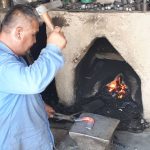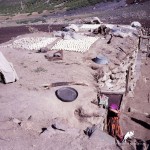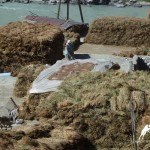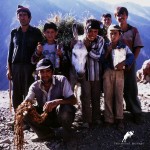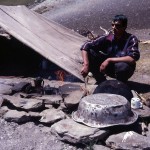The Yagnob Valley in north-western Tajikistan is home to an interesting tribe of people: the Yagnobi. These people, despite decades of forced removal by the Soviets, have managed to hold onto their fascinating ancient traditions and cultures from fire rituals to traditional medicinal practices that you can still witness today.
The Yagnobi people are the last native speakers of the ancient Sogdian language, also known today as the Yaghnobi language. What is interesting about this language is that the ‘keepers’ of it are women. Yagnobi is mostly spoken around the home and with family, while men often prefer to use the Tajik language for formal and business matters. The Yagnobi language is passed on to the children through their parents, but thanks to an ever-changing landscape and western influence, the language is considered at risk of becoming a dying language.
Even though most of the Yagnobi were forcibly converted to Islam by the Arabic invaders at the battle of Mount Mugh in 722 CE, they still practice a few Zoroastrian (fire worshipping) traditions, principles, and superstitions, such as the celebration of Navruz, the feast of spring, and the taboo of shaking the water off your hands after washing them. Plenty of festivities are celebrated with fire jumping – the act of literally leaping over open fires. After a wedding, the bride is taken around a bonfire before they can enter the groom’s home where they will find a lit candle waiting for them. Even today, in a culture that celebrates fire, blowing out a candle is prohibited in the Yagnob Valley.
The Yagnobi people believe in saints and spirits and have several shrines and mazors (holy places or burial vaults) scattered around the valley. Here, the local people will place little figurines of sheep, horses or goats made out of clay. It is believed that these animals come alive at night and head down to the river to negotiate with evil spirits. If a figurine is damaged, then it believed that the saint did not accept the sacrifice.
The Khoja Guliston is a famous shrine located at Hishortob, not far from the village of Margeb. The legend behind the shrine is that a local woman transformed herself into stone to save herself from an army invasion. The Guliston rock can be found inside a rustic stone hut, but only women are allowed to enter and a small donation is expected.
Another interesting tradition can be seen at Khatti Mullo mazor in the village of Sokan. The ceremony involves a man walking around a large rock and a tall column inside the mazor. He has to do this three times and after each loop, he hugs the column until the tips of his fingers touch on either side. If they touch, his wishes will be commanded, but it is a bad omen if they do not.
It is not all bad superstition though. The Yagnobi people also believe in folklore healing and traditional medicine to bring good luck and treatment to those suffering from typical ailments. Traditional medicine includes the use of plants, amulets and magic therapy – traditions practiced mainly by women. Today, the Yagnobi women still use plant therapy to create natural mouthwashes and anesthetics.
With a focus on getting the most out of nature, the Yagnobi make a living through shepherding and subsistence farming. Most of the farmland is made up of summer crops, with the majority used for growing barley, peas, and wheat. Potatoes were brought to the valley after World War II and grow very well here. Nearly every family owns a donkey, a cow, and herds of sheep. Cattle is sold at the market or exchanged for staples such as rice and flour.
While a popular destination for trekking and hiking in Tajikistan, the Yagnob Valley feels as though it stands still in time. The local people are warm and friendly, and many of them offer rooms to rent in their homes where you can experience an authentic homestay. However, due to the village’s remote location, the region is very poor and you should provide money and food supplies despite their generous hospitality. Interestingly, despite being Muslim, the women do not wear a hijab – even around strangers – and you will likely come into contact with the whole family, not just the men.
The Yagnobi people are a fascinating group of people with age-old traditions and cultures that are fascinating to experience and study. You can combine a visit to these ancient Sogdian villages in the Yagnob Valley with any other Paramount Journey tour or itinerary. Take a look at our website for more information!






